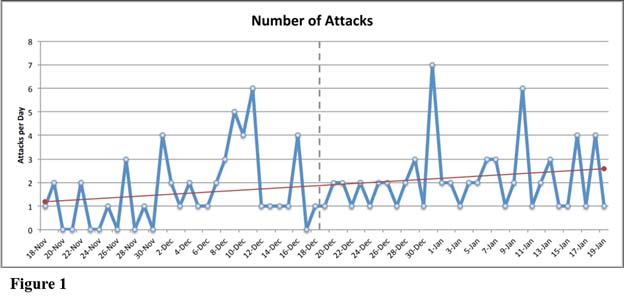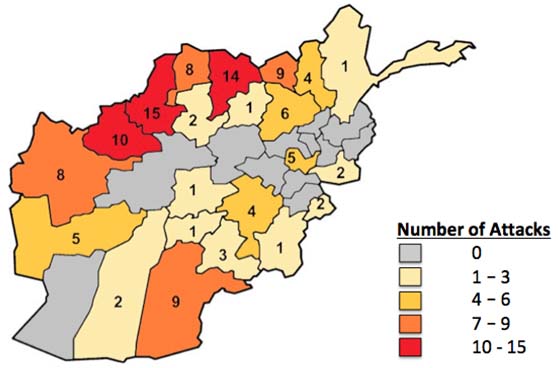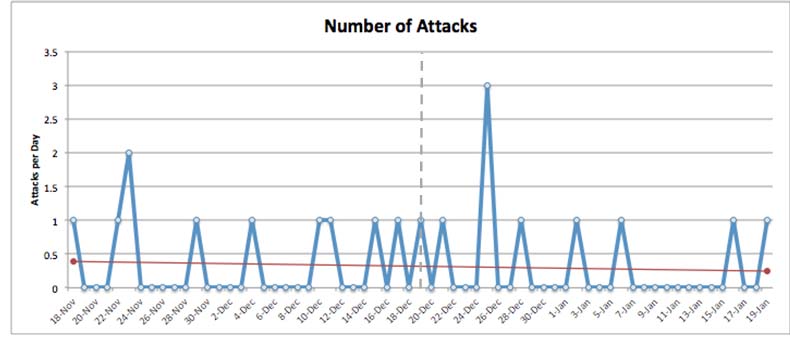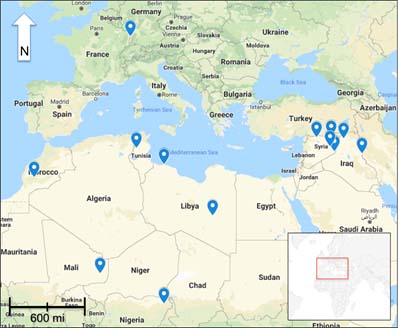Unintended Consequences of the Message Surrounding US Withdrawal from Afghanistan and Syria
Thomas Hader, Peter K. Forster and Chris Kong
Introduction
As the Syrian Democratic Forces (SDF) dealt final blows to Islamic State in Iraq and Syria’s (ISIS or Daesh) physical caliphate, the specter of an American reduction in forces in the Syrian theater complicated the next phase in the conflict. On December 19, 2018, President Donald Trump tweeted, “Starting the long overdue pullout from Syria while hitting the little remaining Islamic State territorial caliphate hard, and from many directions.” [i] Less than 24 hours later, the Trump Administration ordered a pullout of 7,000 troops from Afghanistan.[ii] These decisions and the process by which they were executed ignored a basic premise of risk management -- balancing the assumed threat reduction with costs and unintended consequences. These consequences include a large morale boost for terrorist organizations operating in the region and beyond, uncertainty for US allies, and confusion amongst US military leaders whose comments are carefully considered in deference civilian control of the armed forces.
Within this context, the proposed actions must be weighed to determine strategic and operational costs and reduce countervailing risks. Theoretically, information should be collected from multiple sources, analyzed, and a clear classified directive released. In this instance, these factors were, at least partially, disregarded. In effect, US operational commanders and allies were bypassed. Simultaneously, foreign terrorist organizations (FTOs) in the region initiated an operational up-tempo. This trend is evident in the spread of propaganda and an increase in deadly attacks following the decision.
This study determines what trends, if any, may be associated with the announcements of US troop withdrawals in both Syria and Afghanistan on December 19 and 20, respectively. It examines the extent to which linkages exist between the unintended consequences and the announcement of the US military’s withdrawal by examining activities and commentary associated with the Taliban, the SDF, and the Daesh.
Methodology
The study explores whether noticeable changes exist in activity surrounding the non-state actors operating in the region after the referenced announcements. It uses only open source materials to examine a varied of data points for a two month period (i.e., one prior and one after) surrounding the withdrawal announcement. It focuses on ISIS the Taliban, the Peshmerga and the SDF providing a juxtaposition between the enemy and allied response. For the FTOs, data includes the number of attacks during the time frame, as available through open source, and recruitment and public messages. Determining message intent tends to be a subjective process; however, in this study, the breakdown of message type is less impactful because the researchers are assessing messages for an obvious shift in organizational morale. Within this context, the study uses the following broad framework:
- Public messages reflect commentary of a general nature on a specific operational development.
- Recruitment messages are direct appeals to join an organization.
- For the Kurdish forces, only data surrounding recruitment and their online presence was collected over the same period. The data was analyzed within the context of pre-existing geopolitical factors, to determine if any noticeable trends might be attributed to comments on the change in US force structure.
Taliban
US military involvement in Afghanistan since 9/11 has been complex and dynamic. The original task was eliminating the attack’s perpetrators and conspirators (e.g. Taliban, Al-Qaida) and preventing the country from returning to a safe haven for terrorist groups. It later evolved into stabilizing the Afghan government and transferring the responsibility for security to the Afghan National Security Forces (ANSF). These significant shifts in strategy occurred in 2015 under the initiation of Operation Freedom’s Sentinel under which the ANSF took the lead in securing the country. Over the four years since this shift, limited decisive progress has been made and instead the conflict has seemingly reached a stalemate. The DNI’s 2019 Worldwide Threat Assessment corroborated this point stating that, “neither the Afghan Government nor the Taliban will be able to gain a strategic military advantage in the Afghan war in the coming year if coalition support remains at current levels.” [iii] However, the announcement of troop withdrawal appears to have broken the stalemate in the Taliban’s favor.

Figure 1
In the wake of the Trump Administration’s order to withdraw approximately one-half of US troops from Afghanistan, there has been evidence of a shift in the levels of violence attributed to the Taliban. Figure 1 presents the number of Taliban or Taliban affiliate attacks one month prior to and post the withdrawal announcement on December 19, 2018.
The graph also shows a trend line. Prior to the news breaking, between November 18, 2018, and December 18, 2018, there were a total of 51 attacks attributed to or claimed by the Taliban. These include three high-profile attacks, a coordinated effort against a multinational security company compound that included multiple attack vectors specifically a vehicle-borne improvised explosive device (VBIED) and a ground assault resulting in at least 10 deaths.[iv]
Interestingly, one month post the withdrawal announcement, between December 19, 2018, and January 19, 2019, 69 attacks occurred, a 35 percent increase from before. Traditionally, it is common for fighting to decrease during this time of year due to the low temperatures and harsh weather, however that was not the case. Furthermore, whereas there were eight days without an attack in the month leading up to the withdrawal announcement, there was at least one daily attack attributed to or claimed by the Taliban following the announcement. Last, while outside the scope of collection, one of the highest casualty attacks on record occurred on January 21 at a military training center leaving 126 dead.[v] Figure 2 displays the attacks attributed to the Taliban in the two-month reporting period by province.

Figure 2
The most targeted regions are rural provinces with little or no US presence but these provinces are home to about three quarters of the population. The Taliban historically have more influence in rural areas and within the last two months have conducted operations in their own territorial bounds. If the US presence is to be cut back the ANSF will be tasked with securing the areas once reinforced by US forces. This will leave the ANSF stretched and short-handed, a vulnerability the Taliban will likely exploit. As a result, it may be assumed, in the wake of the draw down, that attacks in regions that have recently remained relatively free of violence will increase.
Additionally, morale among combatants also was considered. Some members of the Taliban took the announcement as a sign of an impending US defeat. Unlike ISIS, the Taliban is not known for focusing its dissemination of propaganda online. However, in this instance there was a recorded response to the message from a Taliban commander speaking anonymously who stated, "We proved it to the entire world that we defeated the self-proclaimed world’s lone superpower," and directed other commanders to intensify their training efforts.[vi] Furthermore, within one week a new video was uploaded to Twitter showcasing the training regimen of a Taliban commando unit in which their members were shown conducting basic physical training and combat related training. It is the researchers’ assessment that the video was intended for both recruitment and as a public show of strength. In contrast, Afghan generals fear the news is having a substantial negative impact on the already low morale of the ANSF and even more alarming is the claim that the organization may collapse, which if it were to occur would lead to the return of warlords.[vii]
Finally, the role of ongoing US-Taliban peace talks cannot be discounted in influencing the increased violence. In the summer of 2018, the Trump administration shifted its strategy on Afghanistan, sending delegates to begin laying the groundwork for an end to the violence through negotiations.[viii] In the months following this policy change, the Taliban began increasing its attacks, in part, to undermine the ANSF in order to have more leverage at the negotiation table with US policymakers.[ix] The various geopolitical variables affecting Afghanistan at this point in time make determining a single cause for the increase in violence not only implausible, but attempting to do so would be misleading. It is instead a combination of variables, with the Taliban’s goals to undermine negotiations coupled with the message of US withdrawal two of the leading factors.
Islamic State
Kurdish forces, backed by the US, have been successful in destroying the Islamic State of Iraq and Syria’s (ISIS) physical territory culminating with the fall of Baghouz, Syria on March 23, 2019.[x] In spite of losing its territory in Syria, ISIS still poses a viable threat to the region. There is near unanimous recognition that the ideology continues to attract adherents and that ISIS has both the capability and intent to pursue an insurgency in Syria and Iraq and elsewhere. Furthermore, as ISIS 2.0 or perhaps more appropriately 4.0 takes form, it is important to recall the critical role the US military played in orchestrating and supporting the coalition that ultimately destroyed the caliphate.
At the time that the US announced withdrawal, ISIS held about one percent of territory in Syria. The decision to announce a withdrawal sparked confusion amongst US allies and objections from military leaders and advisors, the consensus being that the decision to pull out at such a critical point might allow for a resurgence. Interestingly, the withdrawal did not occur and on January 6, 2019, the message regarding the pullout from Syria was dismissed by National Security Advisor John Bolton, stating that “U.S. troops will not leave northeastern Syria until Islamic State militants are defeated and American-allied Kurdish fighters are protected.” [xi] In the period between the initial announcement of the withdrawal and Bolton’s comments walking back the president’s directive, ISIS was active attacking civilians and military forces including US troops.
Depicted below in Figure 3 is a summary of the ISIS attacks during the research period. Figure 4 displays the locations of the recorded attacks.

Figure 3
Between November 17, 2018, and December 17, 2019, the month preceding the withdrawal announcement, there were ten attacks attributed to ISIS worldwide including attacks in Nigeria, France, and Libya as well as Syria and Iraq. The dispersed nature of the attacks indicates that most were conducted by ISIS-affiliated cells, and thus do not necessarily reflect any tie to what was occurring in Syria. However, the most fatal attack occurred on November 23, 2018, in which ISIS militants killed 24 U.S. backed fighters in Syria.[xii]

Figure 4
In the post- announcement period from December 19, 2018, to January 19, 2019, there was a total of nine reported ISIS-affiliated attacks which took place in France, Libya, Iraq, Nigeria, Morocco, Syria, and Tunisia. These attacks occurred with more frequency, every other day and included a spike on Christmas day. Although not as deadly as the November 23 attack, the most fatal attack in the post-announcement reporting period occurred on January 16, 2019, in Manbij, Syria. During this time, two US service members and two US civilians were killed and three injured.[xiii] Overall, the post-announcement period recorded a minor decrease of attacks while still targeting US personnel. Ultimately, there does not appear to be any correlation between the announcements and ISIS activity.
Notwithstanding, despite the lack of significant supporting attack data, the post-announcement period did reflect the resurgence of a directed ISIS online message. On January 3, 2019, ISIS’ newsletter Al-Naba published an article titled Then They will be Overcome, which was an official retort responding to President Trump’s tweets.[xiv] The newsletter claims President Trump’s declared victory over ISIS in Syria was as mistaken as President Obama when the latter declared the mission over in Iraq in 2011. It further remarked on the expansion of the Islamic State in Khorasan, Somalia, Central Africa and elsewhere, “despite the billions of dollars spent to destroy them.”[xv] The newsletter culminates by stating that the jihad is not over, as evidenced by their expansion to new territories.
The release of a directed message that was propagated online was a deviation from the trend seen in the month prior. A study found that a major decline occurred in ISIS content online from 2016 through 2017 which corresponded with the eradication of their physical caliphate as well as a major crackdown from media platforms. [xvi] In response the group turned to localized outlets to spread their message, and a steady stream of propaganda continued to be released. One month prior to the attacks there were no noticeable trends from the baseline. ISIS linked groups continued to post praise for their achievements and ISIS released a new installment of an ongoing video series detailing their operational success. A directed message however shows that the group continues to look for any way to exploit coalition forces to empower its sympathizers, and its release should not be disregarded.
In addition to the official media release, there are also recorded incidents of ISIS members hacking thousands of Twitter accounts in the aftermath of the withdrawal announcement to share photos and videos calling for violence.[xvii] Many of the photos displayed ISIS fighters wielding weapons and portraying a show of force in a likely attempt to recruit new members.[xviii] Tweets also included directions on building explosives and aspirations to turn the holidays “into grief and horror” indicating an effort to inspire action among sympathizers outside of Syria.[xix] ISIS’s continued attacks in the post- announcement period and its online presence supports the contention that the group is not likely to disappear in spite of no longer controlling territory. In fact, the geographic dispersion of ISIS fighters may well mean the increased possibility of a resurgence of random attacks against soft targets throughout the Middle East, Europe, and even the Americas. The key factors in determining ISIS’ capability will be its command and control structure, communication between cells, and each cell’s ability to operate independently.
Looking back at previous lessons learned, the group was adept at using the internet to not only spread its propaganda, but recruit members, direct operations, and inspire attacks internationally. From its inception, ISIS was quick to adapt their tactics for the digital age. They have adapted again and are leveraging new innovations such as the TOR network, end-to-end encrypted (E2E) messaging systems, and pretty-good-privacy (PGP) email to obscure their activities from law enforcement and intelligence agencies while continuing to spread their messages. Most recently, ISIS expanded to a decentralized peer-to-peer hosting network called ZeroNet. The web application’s architecture which uses Bitcoin cryptography and a BitTorrent network makes it impossible to take down a site as long as there are seeders. This characteristic made it appealing to ISIS, which is using it as a vessel to host propaganda videos, provide updates on ISIS inspired attacks, and provide links to Telegram chat rooms. More critically, these new tools allow for decentralized leadership and wider autonomous operations resulting in more self-sufficient infrastructure and fewer opportunities for surveillance.
Moving forward, although ISIS no longer controls territory, they still possess the ability to communicate and thus remain a threat. We had already seen a shift in their TTPs towards more guerilla-style warfare.[xx] Seth G. Jones, a senior advisor at the Center for Strategic and International Studies, explained: “When you lose territory, smart groups shift to guerrilla strategy and tactics, included targeted assassinations, ambushes, raids, bombings, that is how you wear the enemy down.”[xxi] This strategy was present on the attack in Manbij, and will likely continue into the future. Furthermore, its intelligence service, EMNI, has 150,000 operatives worldwide according to Israeli intelligence and a $400 million “war chest”. [xxii] The Trump administration has made extensive progress in the fight against ISIS, but there clearly was a backlash from the announcement of an early victory and decision to pull out of Syria before it could be officially declared, which should be heeded moving forward.
Syrian Democratic Forces
The announcement of the withdrawal of US forces from Syria was alarming news to the SDF. Since its inception in October 2015, the SDF has enjoyed US support in a joint mission to eliminate ISIS forces in Syria and to destroy the physical caliphate. Not only were US forces embedded in both an operational and advisory capacity, but the US provided ample material support. While celebrated amongst FTOs, the abrupt news of a withdrawal of US troops from Syria caused Kurdish forces to begin readjusting their ground strategy.
In the early stages of the Kurdish effort against ISIS, the online domain became a coordinated effort aimed at recruiting and vetting foreigners to join pro-Kurdish forces, collect donations, and inspire pro-Kurdish sovereignty.[xxiii] The SDF forces maintained a prominent online presence as a media outlet.[xxiv] But in late 2015, with the official deployment of US Special Forces alongside the Kurds, there was a shift away from strategic online efforts. This marked a transition not only in the Kurdish struggle for legitimacy on the world stage, but also a move away from the recruitment of foreign fighters, who were deemed a potential risk to their emerging regional power and legitimacy.[xxv] Ultimately, the Kurds no longer sought support from small groups of private individuals who were once part of their overall strategy.
At its peak, Westerners interested in joining the front lines to help Kurds fight against ISIS were contacting recruiters through social media and receiving support through a network that not only vetted them but helped facilitate travel by providing logistical information and offering in-country training.[xxvi] With news emerging of the US departure, a resurgence in the once active online environment might be expected. The resurgence did not occur. Whereas propaganda was being circulated online by ISIS and the Taliban less than a week after Trump’s announcement of US withdrawal, there was no mention of a possible re-establishment of the foreign fighter recruitment on any official or unofficial Kurdish social media pages. In fact, the only post found mentioning recruitment was on an unofficial Facebook page with loose ties to the Peshmerga.
This page was created to aid Westerners with military experience in their journey to the front lines and the information passed on it is not likely to come from any official sources within the SDF. More interesting is that the post did not discuss the need for more volunteers. It was written to inform visitors that the group is only looking for individuals with military experience and at least one deployment to even apply.
The online environment is not likely to revert to seeking foreign volunteers, instead the Kurds are now looking to step into the world stage. Two weeks after his initial decision, Trump, at the behest of military and diplomatic personnel, reversed his decision to withdraw stating that US forces would now be withdrawing “over a period of time” to protect Kurdish troops.[xxvii] Their success against ISIS has changed the Kurds dynamic and unless there is a major power shift (i.e. a Turkish invasion) it is almost certain the Kurdish leaders will likely look to allied nation-states to support their independence rather than pursue a resource intensive recruitment of foreign fighters who also present a possible public relations blowback. Upon learning of the US pullout, Kurdish leaders sought aid from Russia and even Syrian government forces as a protective measure from a Turkish invasion.[xxviii] With ISIS eliminated from its last strongpoint, and US troops poised to remain as advisors, the Kurdish position is, at least, temporarily secured. Notwithstanding, no clear US policy exists, and policy makers should carefully consider the message being sent as well as potential instability and discord resulting from abandoning a regional ally like the SDF.
Conclusion
Edward Luttwak provided some guidance as to how wars end and which methods are most effective. According to Luttwak, there is either a victor and a vanquished, a cease-fire based upon war-induced exhaustion, or an imposed armistice.[xxix] Each is fraught with its own challenges. None of these models appear to apply to conflicts discussed here, although retiring from the battlefield even while claiming victory is not a clear victory in this sense. From the data presented here, the biggest inference that can be drawn from the unexpected announcement to withdraw US forces from both Iraq and Syria is that its manner and phrasing had negative effects in promoting a stable and cohesive policy in its aftermath. The announcements may be attributed to playing a part in the increased or continued violence from the terrorist organizations operating in the regions examined. An increase in the number of violent attacks by the Taliban in the month after the announcement was evident but many factors contribute to the frequency of terrorist operations.
What also is clear from the information gathered is that confusion from military leaders who had not been briefed in advance of the presidential tweet, were confused and frustrated with the division in the chain of command. CENTCOM Commander General Joseph Votel in a public forum discussed the fact that he was not privy to the decision prior to its announcement.[xxx] The same message was echoed by the Commandant of the Marine Corps General Robert B. Neller, who was left uncertain of what guidance to give his Marines.[xxxi] The most surprising consequence was the resignation of Secretary of Defense, James Mattis.
Finally, this study found rhetoric specifically mentioning the tweet and subsequent messages used to strengthen morale. Although there was not an increase in attacks by ISIS in the month after the announcement, the group did change its procedures and specifically coordinated an attack to target US forces. Furthermore, they released a message online to belittle the tweet’s claim of victory that accompanied the announcement of withdrawal and encourage a show of strength amongst its ranks. Last, it was determined that Kurdish leaders were not prepared to reinvigorate their once robust online recruitment campaign but instead were prepared to look to Russia for aid amid the possibility of US abandonment. Moving forward, it should be standard procedure for policy makers to consider the countervailing risks of making public announcements without holding dialogue with those leading the response. While this may not result in consensus, it eliminates the more detrimental frictions that can erode the effectiveness of an overall strategy when commanders are caught off-guard by policy makers.
End Notes
[i] https://twitter.com/realDonaldTrump/status/1084584259510304768
[ii] https://www.nytimes.com/2018/12/20/us/politics/afghanistan-troop-withdrawal.html
[iii] https://www.dni.gov/files/ODNI/documents/2019-ATA-SFR---SSCI.pdf
[iv] https://www.theguardian.com/world/2018/nov/28/taliban-deadly-attack-on-g4s-compound-in-kabul
[v] https://www.nytimes.com/2019/01/21/world/asia/afghanistan-taliban-attack-intelligence-wardak.html
[vi] https://www.nbcnews.com/news/world/taliban-greets-pentagon-s-withdrawal-troops-afghanistan-cries-victory-n950811?cid=sm_npd_nn_fb_ma
[vii] https://www.marinecorpstimes.com/news/your-military/2018/12/21/a-blow-to-morale-afghan-generals-worry-about-us-withdrawal/https://www.marinecorpstimes.com/news/your-military/2018/12/21/a-blow-to-morale-afghan-generals-worry-about-us-withdrawal/
[viii] https://www.nytimes.com/2018/10/18/world/asia/afghanistan-us-taliban-ashraf-ghani.html
[ix] https://www.bbc.com/news/world-asia-45507560
[x] https://www.reuters.com/article/us-mideast-crisis-islamic-state/islamic-state-caliphate-defeated-yet-threat-persists-idUSKCN1R407D
[xi] https://ktla.com/2019/01/06/u-s-to-leave-syria-once-islamic-state-defeated-kurds-safe-trump-adviser/
[xii] https://www.garda.com/crisis24/news-alerts/179161/syria-is-kills-24-sdf-fighters-in-deir-al-zor-province-november-23
[xiv] https://www.terrorism-info.org.il/app/uploads/2019/01/E_005_19.pdf
[xv] Ibid.
[xvi] https://www.terrorism-info.org.il/app/uploads/2018/01/E_264_17fv.pdf
[xvii] https://www.engadget.com/2019/01/02/hackers-seize-dormant-twitter-accounts-for-isis-propaganda/
[xviii] Ibid.
[xix] https://www.thesun.co.uk/tech/8109449/isis-hackers-twitter-terrorist-propaganda/
[xx] https://www.thesun.co.uk/tech/8109449/isis-hackers-twitter-terrorist-propaganda/
[xxii] Ibid
[xxiii] Ibid.
[xxiv] See Hader, T. and Forster P. “Virtual Recruitment of Foreign Fighters and Their Threat Upon Return: The Case of the Peshmerga and the People’s Protection Units” Small War Journal. online @ http://smallwarsjournal.com/jrnl/art/virtual-recruitment-foreign-fighters-and-their-threat-upon-return-case-peshmerga-and
[xxv] https://www.washingtonpost.com/politics/obame-decides-on-small-special-operations-force-for-syria/2015/10/30/a8f69c0e-7f13-1 1e 5-afce-2afd1d3eb896_story.html?noredirect=on&utm_term=.b84b1f0e7544
[xxvi] http://smallwarsjournal.com/jrnl/art/virtual-recruitment-foreign-fighters-and-their-threat-upon-return-case-peshmerga-and
[xxvii] https://www.reuters.com/article/us-mideast-crisis-syria-trump/trump-gives-no-timetable-for-syria-exit-wants-to-protect-kurds-idUSKCN1OW1GV
[xxviii] https://www.reuters.com/article/us-mideast-crisis-syria-kurds/let-down-by-us-syrian-kurdish-leaders-look-to-russia-and-assad-idUSKCN1OQ18E
[xxix] https://www.foreignaffairs.com/articles/1999-07-01/give-war-chance
[xxx] https://www.defenseone.com/politics/2019/02/top-general-middle-east-says-he-wasnt-consulted-syria-withdrawal/154654/
[xxxi] https://www.axios.com/trump-syria-afghanistan-withdrawal-military-generals-confusion-f95d5100-fb62-4f4f-a590-3c7e1cbadb6b.html
